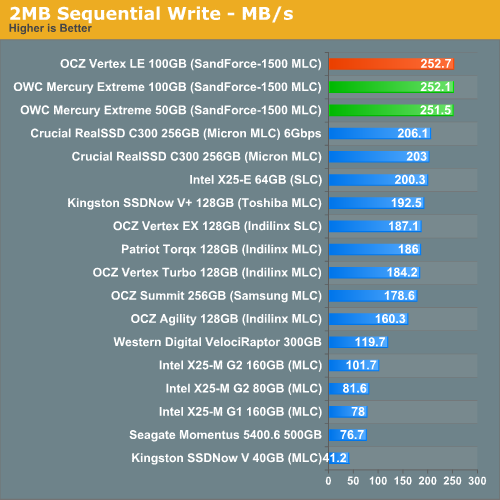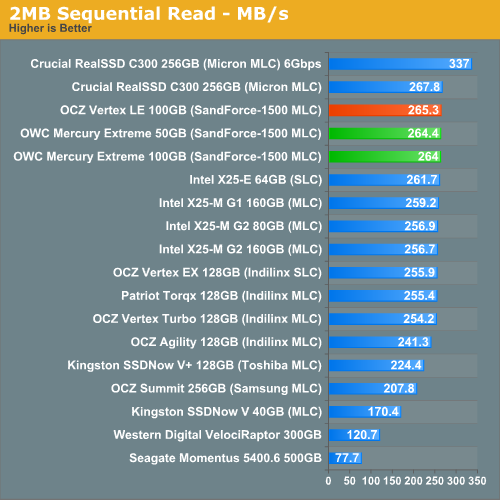OWC Mercury Extreme SSD - First Look at a 50GB SandForce Drive
by Anand Lal Shimpi on February 26, 2010 12:00 AM EST- Posted in
- Storage
Sequential Read/Write Speed
Using the latest build of Iometer I ran a 3 minute long 2MB sequential write test over the entire span of the drive. The results reported are in average MB/s over the entire test length:

Sequential write speed is completely unaffected by the drop in capacity. The 50GB $229 OWC Mercury Extreme performs just as well as the 100GB version from OWC or OCZ. The three also happen to be the fastest SSDs I've tested at this point in terms of sequential write speed.

Sequential read speed is also unaffected. There's absolutely no drop in performance here when you go to the smaller capacity. This is why OWC states that the 50GB drive performs just as well as the 100GB and 200GB drives. The next page will show you why that's a false statement.










74 Comments
View All Comments
Kiru - Monday, March 1, 2010 - link
I've bought a bunch of stuff from OWC (3 external Fire wire drives, and 18 gigs of memory), and had no issues with RMAs when I've needed to (the power supply for one of my externals died). I've had just as many issues with faulty product from New Egg as from anywhere else. But that refurb story IS definitely a pisser. I'm surprised they didn't work with you on that.mobilehavoc - Saturday, February 27, 2010 - link
It's pricey at $800 but still cheaper than the OCZ Vertex LE. I'll be running it in a Macbook with Snow Leopard so internal GC is a nice feature since no TRIM support.Any chance these will be upgradeable via firmware in the future? Or is it you buy the drive and that's it? I'm just nervous about buying something that may not be properly supported for times to come.
Di22yDucRydr1198 - Saturday, February 27, 2010 - link
Do any SSDs support this format which is starting to appear on some conventional HDDs? If one has an Advanced format HDD for storage and a SSD for OS and apps, will the two work together without a hitch?Why is that the Crucial RealSSD C300 256GB falls off so dramatically on the 4k random write aligned to 512-byte sectors?
Thanks for your efforts on this and all the preceeding SSD articles.
Griswold - Sunday, February 28, 2010 - link
I dont think there needs to be advanced format compatibility with SSDs.hyc - Monday, March 1, 2010 - link
And you're completely wrong. Advanced format brings similar benefits to SSDs as for HDDs. Not to mention that most SSDs are already using multiple-of-4KB erase blocks, so it actually has *more* benefit than for HDDs.Anand, your "aligned" random write result for the 50GB drive looks identical to your unaligned result. This looks like a test error to me. At worst, the difference in peak performance should be a factor of 2, due to using half as many channels in the 50GB drive vs the 100GB drive. I think you need to reformat that drive and repeat that test.
kunedog - Saturday, February 27, 2010 - link
At last we get an acknowledgement of the market prices of the G2 X-25M, now that they're finally where they were supposed to be at release. It only took six months for your predictions to come true!http://www.anandtech.com/storage/showdoc.aspx?i=36...">http://www.anandtech.com/storage/showdoc.aspx?i=36...
buzznut - Saturday, February 27, 2010 - link
There are a lot of comments here, so I don't expect this to be read. I am going under the assumption that the data for the Kingston SSD-v 40GB will be the same for the Intel 40GB drive. Many of us have purchased the Intel 40GB as a boot drive. Unfortunately I rarely see it in any benchmarks.I was wondering if there were any plans to do an article on raid performance. Also, are drive manufacturers planning on including trim support for raid at some point? Could we expect a firmware upgrade for this, or would it be for newer drives only?I understand that garbage collection is still available, but that's not the same is it?
I know that filling a drive to capacity is bad, but I have heard that one might leave anywhere from 10%-25% space available on a typical SSD. I have been paranoid about ruining the performance of my drive, so I have been running it at half capacity. Is there a sweet spot between capacity and performance on these smaller 40 GB drives?
Also would any of you recommend adding a second drive in raid 0? It seems to me to be an inexpensive way of adding capacity and performance without shelling out $200+ for a new higher capacity drive (which my wife will surely not approve). Again I am hesitant for the lack of trim support in raid. Will this require much more maintenance on the drive(s)?
greenguy - Saturday, February 27, 2010 - link
As another data point, I have 3 of these drives. I usually just read the kingston 40GB figure as it is the same drive. Performance degradation is something that increases as you read and write to the drive more. The less of this you do, the longer it will last in a near-virgin state.But yeah, I am interested in the questions you ask as well.
jimhsu - Saturday, February 27, 2010 - link
I'm curious about the unaligned vs aligned writes. How are these being set up: formatting NTFS with either 512 bytes or 4096 bytes allocation units? Or something else?Also, being an owner of a X25-M G2, I see that earlier generation drives don't have much variation between the two, while these new generation drives have dramatic variation. How does this translate into real-life performance metrics (i.e. the anandtech bench test)?Are there situations where failing to take advantage of aligned 4K leads to a severe performance impact, compared to the new drives?
semo - Saturday, February 27, 2010 - link
Any chance of seeing articles about PCI-E SSDs? Or are they not being talked about due to cost and/or lack of TRIM?